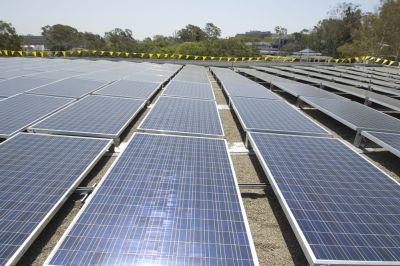Maximising light in optoelectronic devices

Calstatelongbeachphoto
By SolarWriter (Own work) [CC BY-SA 3.0 (http://creativecommons.org/licenses/by-sa/3.0) or GFDL (http://www.gnu.org/copyleft/fdl.html)], via Wikimedia Commons
EU-funded scientists combined metallic nanostructures with semiconductor nanocrystals to significantly improve light trapping in solar cells and photodetector devices.
Colloidal quantum dots (CQDs) are at the centre of a new and rapidly
evolving research field, with the promise for applications in efficient
and cost effective solar cells. Used as the absorbing photovoltaic
material, they have the advantage of having a band gap that can be tuned
simply by changing the nanoparticle size. This allows them to easily
absorb different parts of the solar spectrum.
However, the thickness of the CQD layer is restricted to retain
efficient charge extraction. Thus, novel light-trapping schemes are
required to improve light absorption and efficiency. Plasmonic metal
nanostructures have the potential to further enhance light trapping in
the ultra-thin absorbing CQD layers.
The EU-funded project 'Plasmonically enhanced colloidal quantum dot
photodetectors and photovoltaics' (PECQDPV) studied the optical and
electrical effects of embedding engineered photonic structures in simple
photoconductor and photodiode devices, fabricated from lead–sulphide
(PbS) CQD films.
Using photoconductor test devices with embedded arrays of random,
self-assembled metal nanoparticles that strongly scatter light,
scientists demonstrated a 2.4 increase in photocurrent at wavelengths
around the exciton peaks of PbS quantum dots of a given size.
Furthermore, they studied the electrical effects of embedding other
metal nanostructures in these devices. Depending on the metal, direct
contact with nanoparticles led to photocurrent suppression or
enhancement. These findings were important for designing plasmonic CQD
optoelectronic devices.
Focus was also placed on exploring the physical mechanisms behind
plasmonic enhancement. To this end, scientists performed full-field
optical simulations and developed simple analytical models. In
simulations with Ag nanoparticles, the angular distribution of the
scattered light was found to be relatively narrow, thus reducing its
overall light-trapping potential. Experimental studies showed that mode
structure of the thin semiconductor film is fundamental in determining
the amount of light trapping.
To increase the efficiency of light trapping beyond that provided by
random structures, periodically arranged nanostructures were
investigated. Scientists developed a conceptual model to provide simple
design rules for optimal light trapping in thin films with 2D grating
couplers. The grating couplers were integrated into photodiodes as the
Au back contact, and achieved photocurrent enhancements of up to a
factor of 3 for thin diodes and 1.5 for thick diodes, relative to planar
reference devices of similar thickness.
PECQDPV sought to enhance the absorption of CQD devices by
incorporating plasmonic nanostructures. The findings enhance
understanding of the challenges regarding choice of plasmonic material
and methods that enhance light trapping in a CQD device of particular
geometry.
published: 2015-03-20

